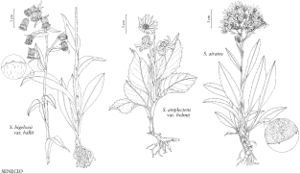Senecio atratus
Pittonia 3: 105. 1896.
IllustratedEndemic
Synonyms: Senecio atratus var. milleflorus (Greene) Greenman Senecio milleflorus
Revision as of 20:11, 29 July 2020 by imported>Volume Importer
Perennials, (20–) 35–70 (–80+) cm (rhizomes or caudices branched, erect to weakly creeping). Herbage floccose-tomentose to canescent, sometimes unevenly glabrescent. Stems 1– (2–5). Leaves progressively reduced distally; petiolate; blades oblong-ovate to oblanceolate, (5–) 10–30 × 1.5–4 (–6) cm, bases tapered, margins dentate (denticles, dark, callous; mid leaves similar, sessile, smaller; distal leaves bractlike). Heads 20–60+ in corymbiform or subpaniculiform arrays. Calyculi of 2–5 linear bractlets (lengths to 1/3 phyllaries). Phyllaries (± 5) ± 8, 6–8 mm, tips black. Ray-florets (± 3) ± 5; corolla laminae 5–8 mm. Cypselae glabrous. 2n = 40.
Phenology: Flowering late spring–early fall.
Habitat: Dry or drying, rocky or sandy sites in coniferous areas, especially sites with frequent disturbance
Elevation: 2800–4000 m
Distribution

Colo., N.Mex., Utah, Wyo.
Discussion
Selected References
None.
Lower Taxa
None.
... more about "Senecio atratus"
introrse +
connate +
papillate +
truncate-penicillate +
scarious +
hispidulous +
papillate +
continuous +
tapered +
nerved +
oblong-ovate;oblanceolate +
winged;nerved;ribbed +
absent +
stigmatic +
persistent +
30;80 +
absent +
not 2-lipped +
monomorphic +
glabrous +
staminate +
straight +
distinct +
proximal +
1;5 +
bisexual +
dispersed +
Dry or drying, rocky or sandy sites in coniferous areas, especially sites with frequent disturbance +
singly +
indeterminate +
20;60 +
Present +
surrounding +
turbinate;campanulate +
petiolate +
alternate +
erect;recurved +
deltate +
dentate +
scarious +
2-carpellate +
inferior +
attached +
anatropous +
persistent +
falling +
tough +
thick +
absent +
connate +
persistent +
distinct +
herbaceous +
falling +
erect +
subequal +
equal +
Pittonia +
1896 +
pistillate +
absent +
fertile +
epaleate +
foveolate +
flat;convex +
fibrous +
exalbuminous +
modifed +
alternate +
clustered +
erect +
2-branched +
glabrous +
papillate +
Senecio atratus +
Senecio +
species +
campanulate +
equaling +
black +
shorter +
perennial +
